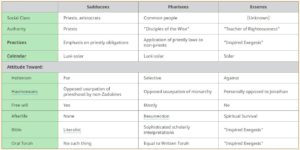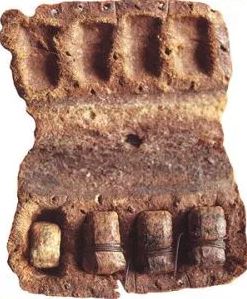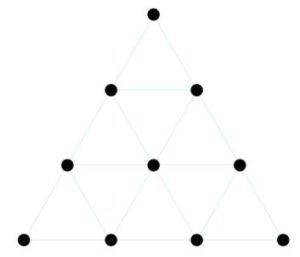On the festival of Shavuot it is customary to stay up all night learning Torah and showing our devotion to God’s Word. Previously, we traced the origins of this custom to the Kabbalists of Tzfat in the 16th century, based on the teachings of the Zohar that date back to Rabbi Shimon bar Yochai in the 2nd century CE. However, there is actually one more historical mention for a tikkun leil Shavuot, of sorts, that predates Tzfat, the Zohar, and even Rashbi. The first-century Jewish sage and philosopher, Philo of Alexandria (c. 20 BCE – 50 CE), describes a ritual where certain Jews would stay up all night on Shavuot:
And after the feast they celebrate the sacred festival during the whole night; and this nocturnal festival is celebrated in the following manner: they all stand up together, and in the middle of the entertainment two choruses are formed at first, the one of men and the other of women, and for each chorus there is a leader and chief selected, who is the most honourable and most excellent of the band. Then they sing hymns which have been composed in honour of God in many metres and tunes, at one time all singing together, and at another moving their hands and dancing in corresponding harmony and, uttering in an inspired manner, songs of thanksgiving…
The ideas were beautiful, the expressions beautiful, and the chorus-singers were beautiful; and the end of ideas, and expressions, and chorus-singers was piety; therefore, being intoxicated all night till the morning with this beautiful intoxication, without feeling their heads heavy or closing their eyes for sleep, but being even more awake than when they came to the feast, as to their eyes and their whole bodies, and standing there till morning, when they saw the sun rising they raised their hands to heaven, imploring tranquillity and truth, and acuteness of understanding. (On the Contemplative Life, XI, 83-89)
Philo calls this sect of Jews the Essenes, or the Therapeutae, the “Healers”. They have become more well-known in recent decades because of their association with the Dead Sea Scrolls. Who were the Essenes? What did they believe? Why did they stay up all night on Shavuot? And how did they come to influence Kabbalah and other mystical movements?
The Holy Ones
Little is known of the ancient Essenes. Most of our knowledge comes from Philo, and a little more light is shed by Josephus (c. 37-100 CE) and Pliny the Elder (c. 23-79 CE). Recall that at the end of the Second Temple era, there were two dominant streams of Judaism: the Perushim (“Pharisees”) and the Tzdukim (“Sadducess”). The former held on to an Oral Tradition while the latter strictly followed the written word of the Torah. The former made up the majority, and were generally supported by the rural masses. The latter were the wealthier, more cosmopolitan minority. Many of the kohanim at the time were Sadducees, and they controlled the Temple.
It is believed that the Essenes were a break-away sect from the Sadducees, though they adopted a number of Pharisee ideas. They were tired of the corruption going on in the Temple, and the hypocrisy of the leaders in the big cities. Many scholars hold that the breaking point was when a certain “Righteous Teacher” (moreh tzedek) was ousted from the role of kohen gadol (most likely during the Hasmonean period) and left Jerusalem to start his own mystical movement in the rural areas. It isn’t clear whether the Essenes already existed before this, or were established by the Righteous Teacher and his disciples at that point.
The Essenes were ascetics, living simply and devoting themselves to God, prayer, and study. In some accounts, they were celibate; others suggest that they did permit marriage, and only the leaders or priests were celibate. They did not drink wine, eat meat, or sacrifice animals. It appears that they held (like the Rambam later would in Moreh Nevuchim) that the sacrifices were only a temporary measure, and never meant to be eternal laws. They did not engage in warfare or commerce. They were so careful with Shabbat that they forbid defecating on that day so as not to have even a bit of impurity. Purification rituals were a big part of their system, and they immersed in a mikveh daily.

Comparison of Sadducees, Pharisees, and Essenes, from the Jewish Virtual Library.
The origin of the term “Essene” is unclear. It may come from an ancient Greek word denoting holiness (οσιον), or from the Hebrew osei haTorah, or more likely, hitzonim (which would have been pronounced hisonim back then), meaning those on the periphery, or “outsiders”. Philo also calls them Therapeutae, which may imply that they were seen as healers, or that the health of both body and soul was of supreme importance to them. The ancient Greek root of the word can mean, more generally, to “serve” or “minister to”, so it might just mean that they were “servants of God”.
One thing that we do know for sure about the Essenes is that, for them, the most important holiday of the year was Shavuot, “the Jubilee feast”. Philo writes that the Essenes
devoted their whole life and themselves to the knowledge and contemplation of the affairs of nature in accordance with the most sacred admonitions and precepts of the prophet Moses. In the first place, these men assemble at the end of seven weeks, venerating not only the simple week of seven days, but also its multiplied power, for they know it to be pure and eternally virgin; and it is a prelude and a kind of fore-feast of the greatest feast, which is assigned to the number fifty, the most holy and natural of numbers, being compounded of the power of the right-triangle,* which is the principle of the origination of the whole [alternately: the source of the creation of the universe]. (ibid. VIII, 64-65)
The Essenes put special emphasis on the number 50, and called Shavuot the “festival of Jubilees”. The Jubilee, of course, is the special 50th year according to the Torah. We’ve discussed before the ancient Book of Jubilees, which records the entire history of the first 50 Jubilee cycles from Creation. It divides up the entire Torah narrative—up to the Sinai Revelation—into chunks of Jubilees and describes what happened in each of them, both summarizing the Torah and adding many more details like a Midrashic text. The Essenes included the Book of Jubilees in their Tanakh and archaeologists have found at least 15 copies of it among the Dead Sea Scrolls, making it one of the most abundant there.
We know that the Essenes followed a unique calendar which is different from the Jewish calendar we use today. As Philo states above, the Essenes devoted themselves both to the Torah of Moses and to the study of nature and God’s Creation. They believed the calendar must be perfect, cyclical, eternal. They didn’t like the fact that the priests of the Temple and the sages of the Sanhedrin proclaimed new months based on “faulty” human observation, and that this resulted in holidays landing on different days. Instead, they divided up the year into 4 equal seasons of exactly 13 weeks each, or 91 days per season, giving a 364-day year of precisely 52 weeks. They did not take the new moons into account like mainstream Judaism, and strictly followed the Sun. (Though how they intercalated the years to stay in synchrony, since the solar cycle is actually 365.24 days, isn’t clear.) The result was that their holidays always took place on the exact same day each year.
This had the greatest effect on Shavuot. The Torah does not specify a date for Shavuot, instead saying that we should count 50 days mimacharat haShabbat, from the day after the Sabbath following Pesach. The approach of the ancient majority—which carried over to the Mishnah and Talmud, and our own tradition—is that this refers to the day following the first yom tov of Pesach, which is also a “Shabbat”. So, we start counting the Omer the night that follows the first seder (ie. the second seder for those in the diaspora). The Essenes, on the other hand, read Scripture here more literally to mean Shabbat specifically, and so they only started the Omer count after the first Shabbat that followed Pesach. This was always a Sunday, and resulted in Shavuot always being celebrated on the 15th of Sivan.
The 15th of Sivan was, by far, the most important day on the Essene calendar. It highlighted what they believed to be their superior calendar and knowledge of nature. It represented the number 50, a most-holy number for them. In the Book of Jubilees, the 15th of Sivan holds immense importance, for this was the day that Noah made a covenant with God after the Flood (Jubilees 6:19), when Abraham made the Covenant of the Parts, when Isaac was born (16:13), and when Jacob defeated Laban and returned to the Holy Land (29:5). It was also when Yehudah was born (28:15), perhaps to signify that it was as if the Jewish people themselves were born on this day! (It may be worth mentioning that the Essenes believed themselves to be the true followers of Judah. They referred to the “wicked” Sadducees as “Menashe”, and to the Pharisees, with whom they generally got along better, as “Ephraim”.)
In fact, the Book of Jubilees is the earliest known source that actually ties the holiday of Shavuot to the Sinai Revelation. The Torah itself doesn’t say this, only referring to Shavuot as a harvest festival and a pilgrimage. It is in Jubilees where this holiday is first associated (at least in writing) with the divine covenant Israel forged at Sinai.
So, it appears that while the Essene calendar did not make it into the Jewish mainstream, their views on Shavuot absolutely did. It was the Essenes that emphasized Shavuot not as a harvest and pilgrimage festival (since they had divested from the Temple community and swore off sacrificial offerings anyway), but as a time to commemorate God’s covenant and His gifting of the Torah. The Essenes were the first to stay up all night in gratitude for this, and in contemplation of the Divine Word. If we look just a little bit further, we will find that this small group of mystical Jews actually influenced a whole lot more.
The First Hasidim
A little-known medieval Jewish work called Sefer Yosifun (“Josippon”, not to be confused with Josephus, whose works are sourced there) refers to the Essenes as Hasidim. The Talmud, too, speaks of hasidim rishonim, “the first pious ones”. They are first mentioned in Berakhot, where the Mishnah (5:1) tells us that they would “meditate deeply for an hour” before starting their prayers. Later (Bava Kamma 30a), we learn that these hasidim were most concerned about, and most careful with, Nezikin and Berakhot. The former deals with laws of damages, and the latter with prayers and blessings. This is very much in line with what we know of the Essenes, who were careful not to hurt other humans (and not even animals), who abstained from any warfare or fighting, and who spent most of their time in prayer, repentance, purification, and contemplation. Altogether, it is quite possible that when the Sages refer to the “first pious ones”, they are talking about the Essenes.
Later in history, we find that much of Essene practice and belief re-emerged in Kabbalistic circles. This includes meditation, angelology, eschatology, and purification rituals. The emphasis on frequent mikveh immersions can’t be overlooked either. We also find a great deal of mystical literature in the Essene canon among the Dead Sea Scrolls. One of the most prominent is the Book of Enoch, which plays a big role in later Kabbalistic texts, too. The ascetic and communal lifestyle, meditative practices, devotion to Torah, and punctilious observance of mitzvot among the Essenes, the hasidim rishonim, would later become associated with the modern Hasidic movement that began in the 18th century.

Earliest known tefillin, discovered in Qumran among the Dead Sea Scrolls
And so, the impact of the Essenes on Judaism is much greater than we normally think.** It is worth pointing out that, incredibly, the most ancient set of tefillin ever found is from the Dead Sea Scrolls. Some scholars therefore believe it was the Essenes who first came up with the tefillin we are familiar with today. As we’ve seen, they were also the first to have a tikkun leil Shavuot. Therefore, while the Essene sect may have disappeared following the Great Revolt and the Roman destruction, a good portion of their beliefs and practices survive to the present, and continue to enrich Judaism today.
Chag Sameach!

Tetractys
*What is meant by the “compounding” of the sevens in the secret of the “right-triangle”? What does this have to do with Creation? I spent quite a while contemplating what this might mean. The best I could come up with: for a right triangle, if each side has a length of 7, then based on the Pythagorean Theorem (which the Essenes surely would have been familiar with), the hypotenuse (the long side of the triangle) would come out to roughly 10. So, “compounding”, or putting together, two sevens in a triangle produces ten. Ten is another holy number, representing the Ten Utterances of Creation and the Ten Commandments. This might explain why they associated the double-seven right triangle with Creation. (Relatedly, the ancient Greek Pythagoreans held the tetractys—a triangle made of ten points—to be a sacred symbol.) For the Essenes, the compounding of the two sevens would have further meaning because multiplying two sevens gives us forty-nine, the intervening days between Pesach and Shavuot which are counted, and the intervening years in the divine Jubilee cycle. Moreover, the triangle is the strongest geometric shape, so it does hold a certain real power. There may very well be some connection here to the mysteries of the Star of David (explored here).

Calculation for a right-triangle with equal sides measuring 7.
**Even more than Judaism, the Essenes appear to have had an even greater impact on Christianity. There are scholars who hold that the Essene sect inspired Christianity directly. There are certainly a number of parallels between the two, including the celibacy of priests, the notion of being “healers”, and the importance of immersion, or “baptism”. John the Baptist himself is thought to have been an Essene at some point. Some scholars have noted that the persona of Jesus very closely resembles that of the Righteous Teacher of the Essenes. The Righteous Teacher seems to have been killed by the authorities for apostasy, and the Essenes awaited his return to usher in the Messianic Age. It is possible, quite ironically, that Jesus sought to present himself as the “second coming” of their long-awaited “Righteous Teacher”!


Pingback: The Kabbalah of Hillel and Shammai | Mayim Achronim
Pingback: Why is Chicken Forbidden with Dairy? | Mayim Achronim
Pingback: A New Theory of Shabbat HaGadol | Mayim Achronim
Pingback: Who Was the First Rabbi in History? | Mayim Achronim
Pingback: The 7 Types of Pharisees | Mayim Achronim
Pingback: The Kabbalah of Solar | Mayim Achronim
Pingback: Origins and Mysteries of Shabbat Candles | Mayim Achronim
Pingback: Mysteries & Secrets of Tefillin | Mayim Achronim